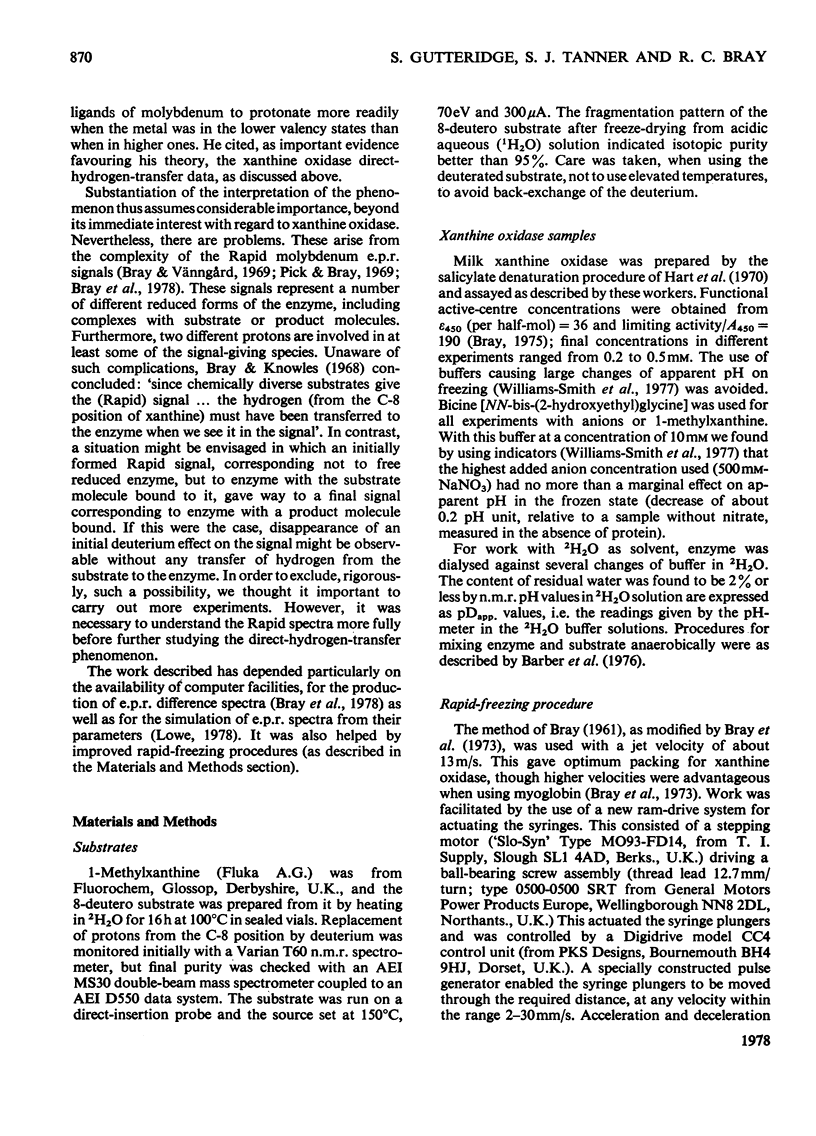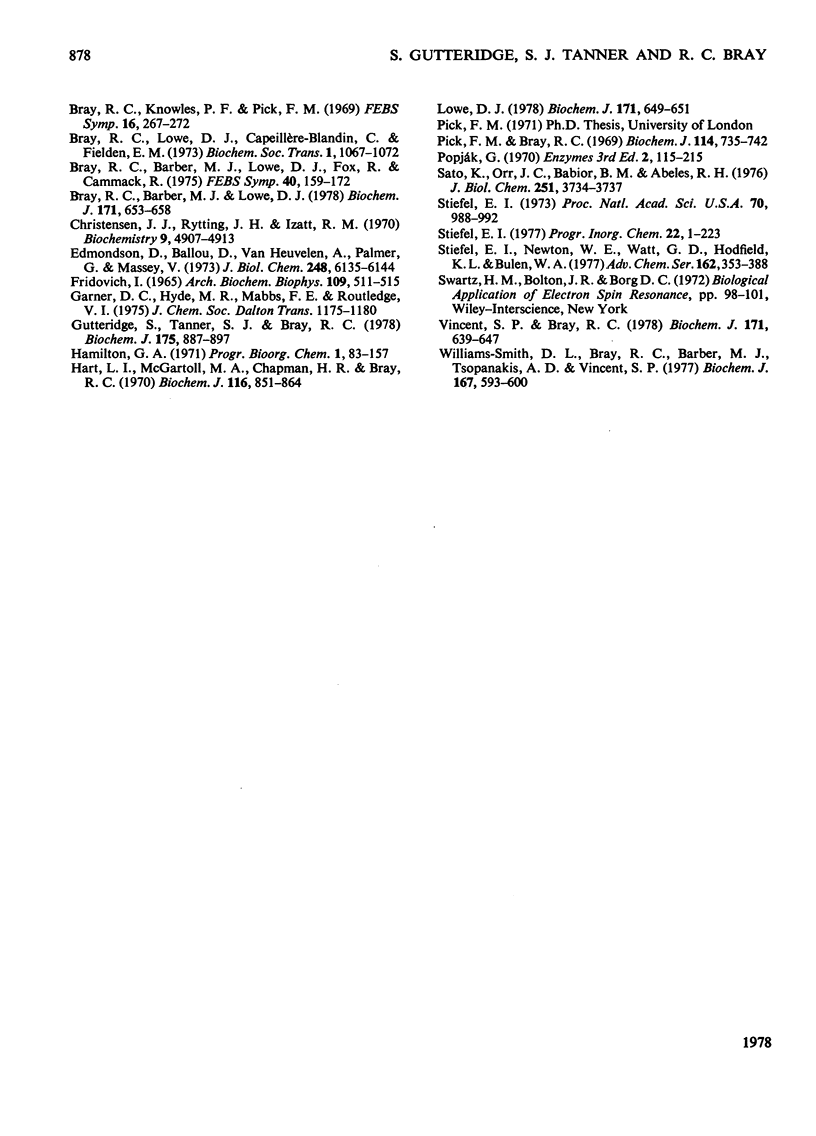Abstract
The observation by Bray & Knowles [Proc. R. Soc. London Ser. A (1968) 302, 351--353] of direct transfer, during the catalytic reaction, of hydrogen atoms from substrate molecules to the enzyme xanthine oxidase was reinvestigated. The experimental phenomenon and its basic interpretation were confirmed and extended. In the reduced functional enzyme, molybdenum(V) interacts with two enzyme-bound protons, which are exchangeable with solvent protons. One of these is coupled to the metal with AHav. 1.4mT and the other with AHav. 0.3mT. The molecule also contains a site for the binding of anions, presumably as ligands of molybdenum. This is shown by effects of nitrate ions on the e.p.r. spectra. The spectra of the nitrate and 1-methylxanthine complexes of the reduced enzyme are very similar to one another, and are designated Rapid type-1 spectra. It is concluded that, in the Michaelis complex, the substrate molecule occupies the anion site, probably being bound to molybdenum via the nitrogen in its 9-position. During the turnover process, hydrogen from the substrate C-8 position, after transfer to the enzyme, appears as the proton more strongly coupled to molybdenum. This proton then exchanges with solvent deuterium with a rate constant of 27s-1, at pH 8.2 and 12 degrees C. It has been confirmed that substrate molecules occupying the anion site do not interfere with observation of the transfer and exchange processes.
Full text
PDF









Selected References
These references are in PubMed. This may not be the complete list of references from this article.
- BRAY R. C. Sudden freezing as a technique for the study of rapid reactions. Biochem J. 1961 Oct;81:189–193. doi: 10.1042/bj0810189. [DOI] [PMC free article] [PubMed] [Google Scholar]
- Barber M. J., Bray R. C., Cammack R., Coughlan M. P. Oxidation--reduction potentials of turkey liver xanthine dehydrogenase and the origins of oxidase and dehydrogenase behaviour in molybdenum-containing hydroxylases. Biochem J. 1977 May 1;163(2):279–289. doi: 10.1042/bj1630279. [DOI] [PMC free article] [PubMed] [Google Scholar]
- Barber M. J., Bray R. C., Lowe D. J., Coughlan M. P. Studies by electron-paramagnetic-resonance spectroscopy and stopped-flow spectrophotometry on the mechanism of action of turkey liver xanthine dehydrogenase. Biochem J. 1976 Feb 1;153(2):297–307. doi: 10.1042/bj1530297. [DOI] [PMC free article] [PubMed] [Google Scholar]
- Bergmann F., Levene L. Oxidation of N-methyl substituted hypoxanthines, xanthines, purine-6,8-diones and the corresponding 6-thioxo derivatives by bovine milk xanthine oxidase. Biochim Biophys Acta. 1976 May 13;429(3):672–688. doi: 10.1016/0005-2744(76)90316-8. [DOI] [PubMed] [Google Scholar]
- Bray R. C., Barber M. J., Lowe D. J. Electron-paramagnetic-resonance spectroscopy of complexes of xanthine oxidase with xanthine and uric acid. Biochem J. 1978 Jun 1;171(3):653–658. doi: 10.1042/bj1710653. [DOI] [PMC free article] [PubMed] [Google Scholar]
- Bray R. C., Meriwether L. S. Electron spin resonance of xanthine oxidase substituted with molybdenum-95. Nature. 1966 Oct 29;212(5061):467–469. doi: 10.1038/212467a0. [DOI] [PubMed] [Google Scholar]
- Bray R. C., Vänngård T. "Rapidly appearing" molybdenum electron-paramagnetic-resonance signals from reduced xanthine oxidase. Biochem J. 1969 Oct;114(4):725–734. doi: 10.1042/bj1140725. [DOI] [PMC free article] [PubMed] [Google Scholar]
- Christensen J. J., Rytting J. H., Izatt R. M. Thermodynamic pK, delta H-o, delta S-o, and delta Cp-o values for proton dissociation from several purines and their nucleosides in aqueous solution. Biochemistry. 1970 Dec 8;9(25):4907–4913. doi: 10.1021/bi00827a012. [DOI] [PubMed] [Google Scholar]
- Edmondson D., Ballou D., Van Heuvelen A., Palmer G., Massey V. Kinetic studies on the substrate reduction of xanthine oxidase. J Biol Chem. 1973 Sep 10;248(17):6135–6144. [PubMed] [Google Scholar]
- FRIDOVICH I. SYNERGISTIC INHIBITION OF XANTHINE OXIDASE BY GUANIDINIUM PLUS THIOCYANATE. Arch Biochem Biophys. 1965 Mar;109:511–515. doi: 10.1016/0003-9861(65)90395-4. [DOI] [PubMed] [Google Scholar]
- Gutteridge S., Tanner S. J., Bray R. C. Comparison of the molybdenum centres of native and desulpho xanthine oxidase. The nature of the cyanide-labile sulphur atom and the nature of the proton-accepting group. Biochem J. 1978 Dec 1;175(3):887–897. doi: 10.1042/bj1750887. [DOI] [PMC free article] [PubMed] [Google Scholar]
- Hart L. I., McGartoll M. A., Chapman H. R., Bray R. C. The composition of milk xanthine oxidase. Biochem J. 1970 Mar;116(5):851–864. doi: 10.1042/bj1160851. [DOI] [PMC free article] [PubMed] [Google Scholar]
- Lowe D. J. Electron paramagnetic resonance in biochemistry. Computer simulation of spectra from frozen aqueous samples. Biochem J. 1978 Jun 1;171(3):649–651. doi: 10.1042/bj1710649. [DOI] [PMC free article] [PubMed] [Google Scholar]
- Pick F. M., Bray R. C. Complex-formation between reduced xanthine oxidase and purine substrates demonstrated by electron paramagnetic resonance. Biochem J. 1969 Oct;114(4):735–742. doi: 10.1042/bj1140735. [DOI] [PMC free article] [PubMed] [Google Scholar]
- Sato K., Orr J. C., Babior B. M., Abeles R. H. The mechanism of action of ethanolamine ammonia-lyase, an adenosylcobalamin-dependent enzyme. The source of the third methyl hydrogen in the 5'-deoxyadenosine generated from the cofactor during catalysis. J Biol Chem. 1976 Jun 25;251(12):3734–3737. [PubMed] [Google Scholar]
- Stiefel E. I. Proposed molecular mechanism for the action of molybedenum in enzymes: coupled proton and electron transfer. Proc Natl Acad Sci U S A. 1973 Apr;70(4):988–992. doi: 10.1073/pnas.70.4.988. [DOI] [PMC free article] [PubMed] [Google Scholar]
- Vincent S. P., Bray R. C. Electron-paramagnetic-resonance studies on nitrate reductase from Escherichia coli K12. Biochem J. 1978 Jun 1;171(3):639–647. doi: 10.1042/bj1710639. [DOI] [PMC free article] [PubMed] [Google Scholar]
- Williams-Smith D. L., Bray R. C., Barber M. J., Tsopanakis A. D., Vincent S. P. Changes in apparent pH on freezing aqueous buffer solutions and their relevance to biochemical electron-paramagnetic-resonance spectroscopy. Biochem J. 1977 Dec 1;167(3):593–600. doi: 10.1042/bj1670593. [DOI] [PMC free article] [PubMed] [Google Scholar]


